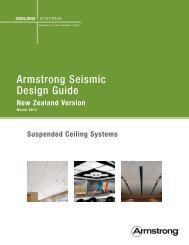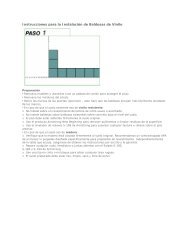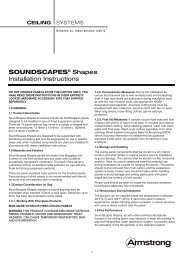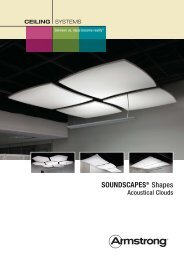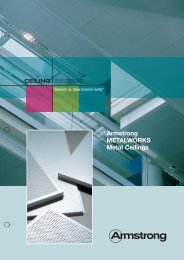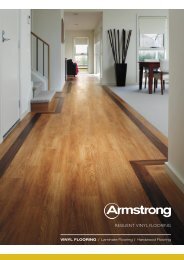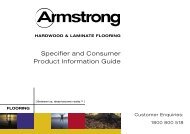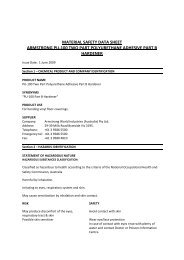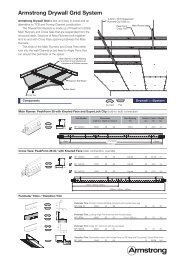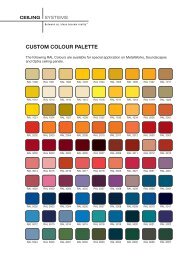Optra & Optima - Armstrong-aust.com
Optra & Optima - Armstrong-aust.com
Optra & Optima - Armstrong-aust.com
You also want an ePaper? Increase the reach of your titles
YUMPU automatically turns print PDFs into web optimized ePapers that Google loves.
CEILINGSYSTEMSBetween us, ideas be<strong>com</strong>e reality Material Safety Data SheetNON-Hazardous Substance, NON-Dangerous Goods1. MATERIAL AND SUPPLY COMPANY IDENTIFICATION• Product name: ARMSTRONG CEILING PANELS: <strong>Optima</strong> & <strong>Optra</strong>:• Re<strong>com</strong>mended use: Panels to reduce noise, improve heating andcooling efficiency for domestic, <strong>com</strong>mercial and industrial buildings.• Supplier: <strong>Armstrong</strong> World Industries Pty Ltd• ABN: 58 000 361 679• Street Address: 99 Derby Street, Silverwater NSW 2128• Telephone: +612 9748 1588• Facsimile: +612 9748 7244• Emergency telephone number: 0412 736 1542. HAZARDS IDENTIFICATIONAUSTRALIA CLASSIFICATIONBased on available information, this material is not classified ashazardous according to criteria of Safe Work Australia.Poisons Schedule (Aust): Not applicableNEW ZEALAND CLASSIFICATIONBased on available information, this material is not classified ashazardous according to criteria of ERMA New Zealand.DANGEROUS GOODS CLASSIFICATIONNot classified as Dangerous Goods by the criteria of the “AustralianCode for the Transport of Dangerous Goods by Road & Rail” and the“New Zealand NZS5433: Transport of Dangerous Goods on Land”.3. COMPOSITION INFORMATIONCHEMICAL ENTITYCAS NO. PROPORTIONMineral wool (slagwool) – Approx. 95%Ingredients determined to be non-hazardous – Balance100%4. FIRST AID MEASURESIf poisoning occurs, contact a doctor or Poisons Information Centre(Telehone Australia 131 126, New Zealand 0800 764 766).• Inhalation: Remove victim from exposure – avoid be<strong>com</strong>ing acasualty. Remove contaminated clothing and loosen remainingclothing. Allow patient to assume most <strong>com</strong>fortable position andkeep warm. Keep at rest until fully recovered. Seek medical adviceif effects persist.• Skin contact: If skin or hair contact occurs, remove contaminatedclothing and flush skin and hair with running water. If swelling,redness, blistering or irritation occurs seek medical assistance• Eye contact: If in eyes wash out immediately with water. In allcases of eye contamination it is a sensible precaution to seekmedical advice.• Ingestion: Rinse mouth with water. If swallowed, do NOT inducevomiting. Give a glass of water to drink. If vomiting occurs givefurther water. Seek medical advice.• Notes to physician: Treat symptomatically.5. FIRE-FIGHTING MEASURES• Specific hazards: Non-<strong>com</strong>bustible material.• Fire fighting further advice: Fire fighters to wear self-containedbreathing apparatus and suitable protective clothing if risk ofexposure to products of de<strong>com</strong>position.• Hazchem Code: Not applicable.• Suitable extinguishing media: Not <strong>com</strong>bustible, however, ifmaterial is involved in a fire use water fog (or if unavailable finewater spray), foam, dry agent (carbon dioxide, dry chemical powder).6. ACCIDENTAL RELEASE MEASURESAvoid accidents, clean up immediately. Wear protective equipment toprevent skin and eye contamination and the inhalation of vapours.Work up wind or increase ventilation. Collect and seal in properlylabelled containers or drums for disposal. If contamination of sewersor waterways has occurred advise local emergency services.Dangerous Goods – Initial Emergency Response Guide No: Notapplicable.7. HANDLING AND STORAGEHandling: Avoid skin and eye contact and inhalation of fibres.Storage: Store in a cool, dry, well-ventilated place and out of directsunlight. Store away from in<strong>com</strong>patible materials described inSection 10. Handle these materials carefully to minimise airborne dust.8. EXPOSURE CONTROLS/ PERSONAL PROTECTIONNational occupational exposure limits:No value assigned for this specific material by Safe Work Australia orDepartment of Labour New Zealand.However for: Synthetic mineral fibres 0.5 fibres/ml.TWA STEL CARCINOGEN NOTICESppm mg/m 3 ppm mg/m 3 CATEGORY– 0.5 fibres/mL – – – –As published by the Safe Work Australia or Department of LabourNew Zealand.TWA – The time-weighted average airborne concentration over aneight-hour working day, for a five-day working week over an entireworking life.STEL (Short Term Exposure Limit) – the average airborne concentrationover a 15 minute period which should not be exceeded at any timeduring a normal eight-hour workday.These Exposure Standards are guides to be used in the control ofoccupational health hazards. All atmospheric contamination shouldbe kept too as low a level as is workable. These exposure standardsshould not be used as fine dividing lines between safe and dangerousconcentrations of chemicals. They are not a measure of relative toxicity.If the directions for use on the product label are followed, exposureof individuals using the product should not exceed the abovestandard. The standard was created for workers who are routinely,potentially exposed during product manufacture.
• Biological Limit Values: As per the “National Model Regulationsfor the Control of Workplace Hazardous Substances (Safe WorkAustralia)” the ingredients in this material do not have a BiologicalLimit Allocated.• Engineering measures: Ensure ventilation is adequate tomaintain air concentrations below Exposure Standards. Avoidgenerating and inhaling dusts. Use with local exh<strong>aust</strong> ventilation orwhile wearing dust mask. Natural ventilation should be adequateunder normal use conditions.• Personal protection equipment: OVERALLS, SAFETY SHOES,SAFETY GLASSES, GLOVES, DUST MASK.Wear overalls, safety glasses and impervious gloves. Avoid generatingand inhaling dusts. If dust exists, wear dust mask/respirator meetingthe requirements of AS/NZS 1715 and AS/NZS 1716. Availableinformation suggests that gloves made from leather should besuitable for intermittent contact. However, due to variations in gloveconstruction and local conditions, the user should make a finalassessment. Always wash hands before smoking, eating, drinking orusing the toilet. Wash contaminated clothing and other protectiveequipment before storing or re-using.9. PHYSICAL AND CHEMICAL PROPERTIES• Form / Colour / Odour: Ceiling panels, white with light grey substratewith no odour.• Solubility: Insoluble in water• Specific Gravity (20°C): Varies by product• Relative Vapour Density (air=1): N App• Vapour Pressure (20°C): N App• Flash Point (°C): N App• Flammability Limits (%): N App• Autoignition Temperature (°C): N App• Melting Point/Range (°C): N App• Boiling Point/Range (°C): N App• pH: N App• Viscosity: N App• Total VOC (g/Litre): N App(Typical values only – consult specification sheet)N Av = Not available N App = Not applicable10. STABILITY AND REACTIVITYChemical stability: This material is thermally stable when storedand used as directed.Conditions to avoid: Elevated temperatures.In<strong>com</strong>patible Materials: Oxidising agents.Hazardous de<strong>com</strong>position products: Oxides of carbon and nitrogen,smoke and other toxic fumes.Hazardous reactions: No known hazardous reactions.11. TOXICOLOGICAL INFORMATIONNo adverse health effects expected if the product is handled inaccordance with this Safety Data Sheet and the product label.Symptoms or effects that may arise if the product is mishandled andoverexposure occurs are:• Acute Effects– Inhalation: Material may be irritant to mucous membranes andrespiratory tract.– Skin contact: Repeated or prolonged skin contact may lead toirritation.– Eye contact: May be an eye irritant. Exposure to the dust maycause dis<strong>com</strong>fort due to particulate nature. May cause physicalirritation to the eyes.– Ingestion: Swallowing can result in nausea, vomiting andirritation of the gastrointestinal tract.• Long Term EffectsNo information available for product.• Acute toxicity/Chronic toxicity<strong>Armstrong</strong> has used historical in vivo studies as the basis fordeveloping predictive models that relate the chemistry of man-mademineral fibres to biopersistence. The results of the predictive modelsindicate that the material fibres used by <strong>Armstrong</strong> to produceceiling products sold in Australia would pass the exoneration criteriaestablished in the European Union Directive 97/69/EC (Note Q).Quality assurance procedures are in place to control the chemistryof the fibres and ensure that they remain constant within theguidelines established by the European Certification Board forMineral Wool Products. In additional, audit procedures are in placeto periodically test for conformation and ensure continued<strong>com</strong>pliance with the biopersistence requirements that enable theexoneration of <strong>Armstrong</strong> products from classification and labelling.<strong>Armstrong</strong> declares that the mineral fibres used by <strong>Armstrong</strong>to produce ceiling products sold in Australia meet the lowbiopersistence set by the European Union under EC No 1272/2008.Note: Safe Work Australia have adopted EC No 1272/2008 as partof the classification criteria of hazardous substances.12. ECOLOGICAL INFORMATIONAvoid contaminating waterways.Ecotoxicity: Expected to be harmless to aquatic organisms.Risk of bioaccumulation in an aquatic species is expectedto be negligible.Expected to be harmless to terrestrial species.Expected to be harmful to bees.Persistence and degradability: The product is not readilybiodegradable.Mobility: No information available.13. DISPOSAL CONSIDERATIONSRefer to State/Territory Land Waste Management Authority.14. TRANSPORT INFORMATION• Road and Rail TransportNot classified as Dangerous Goods by the criteria of the “AustralianCode for the Transport of Dangerous Goods by Road & Rail” andthe “New Zealand NZS5433: Transport of Dangerous Goods on Land”.• Marine TransportNot classified as Dangerous Goods by the criteria of theInternational Maritime Dangerous Goods Code (IMDG Code) fortransport by sea.• Air TransportNot classified as Dangerous Goods by the criteria of theInternational Air Transport Association (IATA) Dangerous GoodsRegulations for transport by air.15. REGULATORY INFORMATIONPoisons Schedule (Aust): Not applicable.All the constituents of this material are listed on the AustralianInventory of Chemical Substances (AICS).16. OTHER INFORMATIONLiterary reference:This MSDS has been prepared as per the “National Code ofPractice for the Preparation of Material Safety Data Sheets 2ndEdition [NOHSC:2011(2003)]”This Material Safety Data Sheet has been prepared by ChemicalData Services Pty Ltd (chemdata.<strong>com</strong>.au) on behalf of its client.Reason(s) for Issue: Revised.Material Safety Data Sheets are updated frequently. Please ensurethat you have a current copy.This MSDS summarises at the date of issue our best knowledge ofthe health and safety hazard information of the product, and inparticular how to safely handle and use the product in the workplace.Since <strong>Armstrong</strong> World Industries Pty Ltd cannot anticipate or controlthe conditions under which the product may be used, each usermust, prior to usage, review this MSDS in the context of how the userintends to handle and use the product in the workplace.If clarification or further information is needed to ensure that anappropriate assessment can be made, the user should contact this<strong>com</strong>pany.Our responsibility for product as sold is subject to our standard termsand conditions, a copy of which is sent to our customers and is alsoavailable upon request.Printed on Zanders Mega Recycled paper ©2013 <strong>Armstrong</strong> World Industries Pty Ltd. AWP0113




